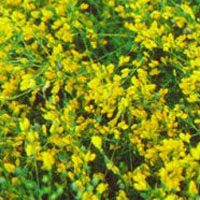Wild Indigo
Uses
Parts Used & Where Grown
The plant is native to the midwestern United States and continues to grow primarily in this region. The root of wild indigo is used medicinally.
Our proprietary “Star-Rating” system was developed to help you easily understand the amount of scientific support behind each supplement in relation to a specific health condition. While there is no way to predict whether a vitamin, mineral, or herb will successfully treat or prevent associated health conditions, our unique ratings tell you how well these supplements are understood by the medical community, and whether studies have found them to be effective for other people.
For over a decade, our team has combed through thousands of research articles published in reputable journals. To help you make educated decisions, and to better understand controversial or confusing supplements, our medical experts have digested the science into these three easy-to-follow ratings. We hope this provides you with a helpful resource to make informed decisions towards your health and well-being.
3 StarsReliable and relatively consistent scientific data showing a substantial health benefit.
2 StarsContradictory, insufficient, or preliminary studies suggesting a health benefit or minimal health benefit.
1 StarFor an herb, supported by traditional use but minimal or no scientific evidence. For a supplement, little scientific support.
This supplement has been used in connection with the following health conditions:
| Used for | Why |
|---|---|
1 Star Common Cold and Sore Throat Refer to label instructions | Wild indigo appears to stimulate immune function and is considered a strong antimicrobial agent. In tinctures with echinacea, boneset, white cedar, and homeopathic arnica, it also has prevented and reduced colds. According to test tube experiments, wild indigo stimulates immune function, which might account for its role in fighting the common cold and flu. In combination with echinacea, boneset, and homeopathic arnica, wild indigo has prevented and reduced symptoms of the common cold in double-blind research. Wild indigo is traditionally considered a strong antimicrobial agent, though it has not yet been investigated as an agent against cold viruses. |
1 Star Infection Refer to label instructions | Wild indigo is both immune supportive and antimicrobial. Herbs that support a person’s immune system in the fight against microbes and directly attack microbes include the following: barberry, echinacea, elderberry, goldenseal, licorice, Oregon grape, osha, and . |
1 Star Influenza Refer to label instructions | Wild indigo contains polysaccharides and proteins that have been reported to stimulate the immune system. It is often used in combination with herbs such as echinacea, goldenseal, or thuja. contains polysaccharides and proteins that have been reported in test tube studies to stimulate the immune system. The immune-enhancing effect of wild indigo is consistent with its use in traditional herbal medicine to fight the flu. However, wild indigo is generally used in combination with other herbs such as echinacea, goldenseal, or thuja. |
Traditional Use (May Not Be Supported by Scientific Studies)
Historically, the root of wild indigo was used to make blue dye. It was also used by European herbalists to treat ulcers and several types of infections, including those affecting the mouth and gums, lymph nodes, and throat.1
How It Works
How It Works
According to test tube experiments, the polysaccharides and proteins in wild indigo are believed to stimulate the immune system.2 This might account for its role against the common cold and flu. Wild indigo is rarely used alone and is a part of a popular European product for colds and flu that combines the herb with echinacea and thuja.3 The root also contains alkaloids, which may contribute to its medicinal actions.
How to Use It
Wild indigo is generally used in combination with herbs such as echinacea and thuja. A tincture, 1–2 ml three times per day, is sometimes used. When taking the whole herb, 500–1,000 mg is taken as a tea three times daily.4
Interactions
Interactions with Supplements, Foods, & Other Compounds
Interactions with Medicines
Side Effects
Side Effects
Higher intakes (over 30 grams per day) of wild indigo can cause nausea and vomiting.5 Long-term use (more than two to three weeks) is not recommended. The safety of wild indigo during pregnancy and breast-feeding has only been established in a product combining it with echinacea and thuja. Used according to the manufacturer’s recommendations, the combination delivers 90 mg of wild indigo per day.
References
1. Hoffmann D. The New Holistic Herbal. Shaftsbury, Dorset, UK and Rockport, MA: Element, 1990, 241.
2. Beuscher N, Kopanski L. Stimulation of immunity by the contents of Baptisia tinctoria.Planta Med 1985;5:381-4.
3. Henneicke-von Zepelin H, Hentschel C, Schnitker J, et al. Efficacy and safety of a fixed combination phytomedicine in the treatment of the common cold (acute viral respiratory tract infection): results of a randomised, double blind, placebo controlled, multicentre study. Curr Med Res Opin 1999;15:214-27.
4. Gruenwald J, Brendler T, Jeanicke C, et al. (eds). PDR for Herbal Medicines. Montvale, NJ: Medical Economics, 1998, 684-5.
5. Gruenwald J, Brendler T, Jeanicke C, et al. (eds). PDR for Herbal Medicines. Montvale, NJ: Medical Economics, 1998, 684-5.
Last Review: 04-14-2015

Copyright © 2024 TraceGains, Inc. All rights reserved.
Learn more about TraceGains, the company.
The information presented by TraceGains is for informational purposes only. It is based on scientific studies (human, animal, or in vitro), clinical experience, or traditional usage as cited in each article. The results reported may not necessarily occur in all individuals. For many of the conditions discussed, treatment with prescription or over the counter medication is also available. Consult your doctor, practitioner, and/or pharmacist for any health problem and before using any supplements or before making any changes in prescribed medications. Information expires December 2024.
This information does not replace the advice of a doctor. Healthwise, Incorporated, disclaims any warranty or liability for your use of this information. Your use of this information means that you agree to the Terms of Use. Learn how we develop our content.

